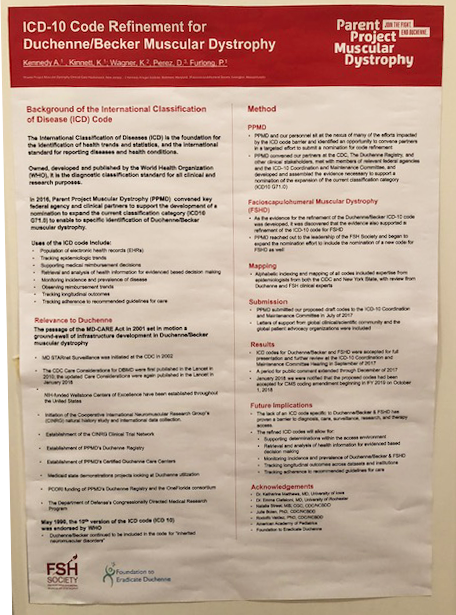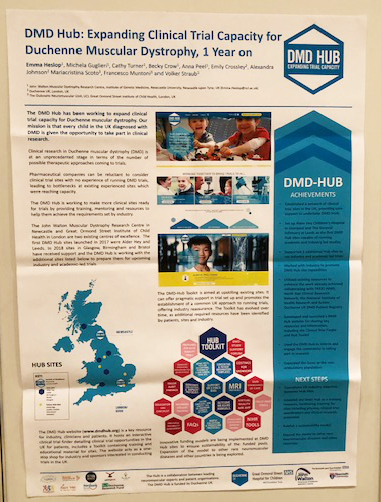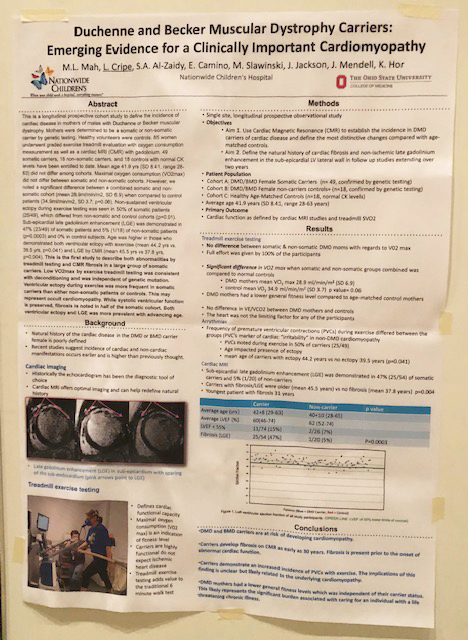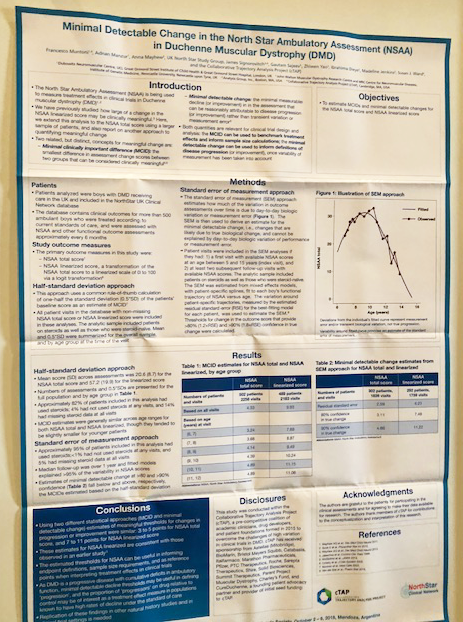
Last week, PPMD’s Founding President and CEO, Pat Furlong and our SVP of Research Strategy, Abby Bronson attended the annual World Muscle Society (WMS) meeting, this year in Mendoza, Argentina.
Pat and Abby have provided a quick overview of some of the updates they heard during the three-day meeting. PPMD was also pleased to present a poster on “ICD-10 Code Refinement for Duchenne/Becker Muscular Dystrophy.”
What is World Muscle Society?
WMS was started 23 years ago by Professor Victor Dubowitz. Dr. Dubowitz led the Great Ormond Street, London clinic for many years. Dr. Dubowitz was one of the first to clinically adopt the use of steroids in Duchenne but, concerned about side effects, utilized a protocol of 10 days on and 10 days off. He also recommended the use of long leg braces (calipers) as a means to extend assisted ambulation well into the teenage years.
Dr. Dubowitz believes it is important for all individuals in the field to meet face-to-face to discuss opportunities, establish collaborations, and to connect at a forum showcasing findings, new investigators, and new knowledge. To that end, WMS and his journal, Neuromuscular Disorders, have grown to become incredibly important for the neuromuscular disease community. From relatively few investigators coming together to today, where over 750 people (bench scientists, young investigators, clinicians, companies, advocacy organizations, and investors) come together in different locations around the world, committed to driving therapies for neuromuscular diseases.
Days are structured with general sessions held in the morning and poster sessions in the afternoon. The poster sessions provide one-on-one discussions with the Primary Investigator (PI), the individual(s) who did the research. The poster sessions are grouped each day.
Wednesday, the first poster session was focused on care (pediatric to adults), natural history, interventions, and outcomes/biomarkers. The late afternoon session was focused on current clinical trials, data, and exciting opportunities in the pre-clinical area.
On Friday, there were a number of talks focused on Duchenne followed by a poster session on pre-clinical studies. This focused on animal models, what we are learning about pathways, and their interaction. Carrier females were also discussed.
Wednesday
- Posters describing natural history studies in various countries demonstrated the critical need for access to optimal care. In Zimbabwe, where there is significant poverty and poor medical care, mean age of loss of ambulation is 9 years and survival 16.
- The DMD HUB, a UK based clinical trials network that informs and engages the UK community to participate in clinical trials with the goal of expanding the network across neuromuscular diseases, presented a poster as well.
Both posters confirm that expanding PPMD’s Certified Duchenne Care Center Program translates into preservation of function and expanded life span.

Several researchers and companies reported clinical trial data from various studies, including the highlights below.
Research highlights:
- Kevin Flannigan from Nationwide Children’s Hospital presented on GALGT2 gene therapy, indicating that regional delivery is well tolerated, without signs of systemic or local toxicity.
- UC Davis’ epicatechin data from the pilot study suggests improvements in circulating biomarkers and exercise performance.
- Outcomes measures and what we are learning from the 4-stair climb and the North Star Ambulatory Assessment (NSAA) and how those measures predict functional loss. These are important learnings for next steps in how trials are designed.
- Nationwide Children’s Hospital Carrier study suggests that carriers, as early as 30 years old, have cardiac fibrosis and demonstrate an increase in PVC’s (premature ventricular contractions) when exercising. Care for carriers is critical.

Industry highlights:
- NS pharma added new data around functional improvement.
- Sarepta Therapeutics announced positive updated results from the four children dosed in the gene therapy micro-dystrophin trial led by Dr. Jerry Mendell.
- Catabasis Pharmaceuticals presented data supporting MRI T2 as a potential marker of clinical outcome in Duchenne.
- PTC Therapeutics announced initial data from patient registry demonstrating Translarna™ (ataluren) slows disease progression in children with Duchenne caused by a nonsense mutation.
The highlight of Wednesday was the Sarepta gene therapy presentation. While the data (CK decrease, dystrophin increase, NSAA change from baseline) was compelling, it was the videos of the young boys that transfixed the audience. Watching those young boys running on the soccer field, going up steps while alternating feet, jumping and rising – literally jumping up from supine to standing – was incredible. And their smiles said it all.
Friday
The Friday morning session was titled “New Therapeutic Approaches” and Eugenio Mercuri presented an overview of the therapeutic strategies being pursued in Duchenne. While most of the information was a review, his main point was that we have learned an immense amount about how to design trials, what are appropriate endpoints, and the feasibility of using an external control in trial design.
We are now trying to understand why some trials failed: was it the wrong expectation based on the preclinical results? Were pilot studies not done appropriately to power the larger studies? Was the study design flawed in some way? Was the endpoint well characterized? He concluded by saying that there is much excitement but we still need to set appropriate expectations as to drug efficacy and the length of time it might take to produce a meaningful change in muscle strength.
Research highlights:
- Professor Kanneboyina Nagaraju (Raju) presented on the potential for an immune response to new dystrophin produced by some of the newer strategies. He showed that some mice had an immune response over time to newly produced dystrophin. While this immune response was not symptomatic, it is important for us to understand if there might be any potential impact on potential therapeutics that seek to produce new dystrophin, and ways to manage this immune response with drugs that are used in other diseases.
- John Tinsley reviewed the Summit data that led to termination of the study. The functional data was conclusive that there was no effect and this was corroborated by biomarker data, including quantitative imaging. While disappointing results, we are glad the results are so conclusive so there is no misinterpretation and are also glad that Summit is willingly sharing knowledge, and when available, data so the community can continue to learn. Just as Professor Mercuri said, we must continue to learn from the past to move forward.




 by: Parent Project Muscular Dystrophy
by: Parent Project Muscular Dystrophy

